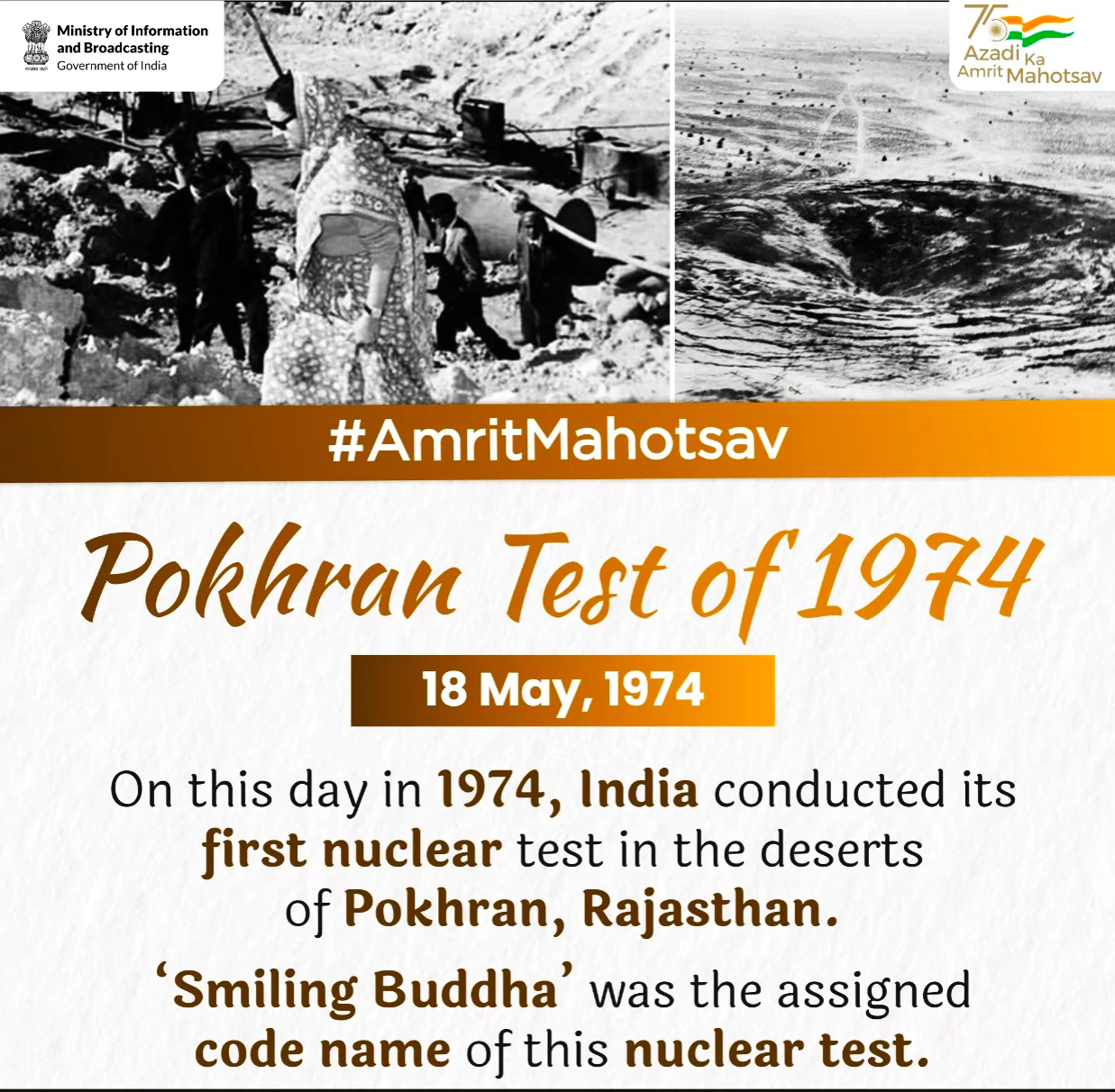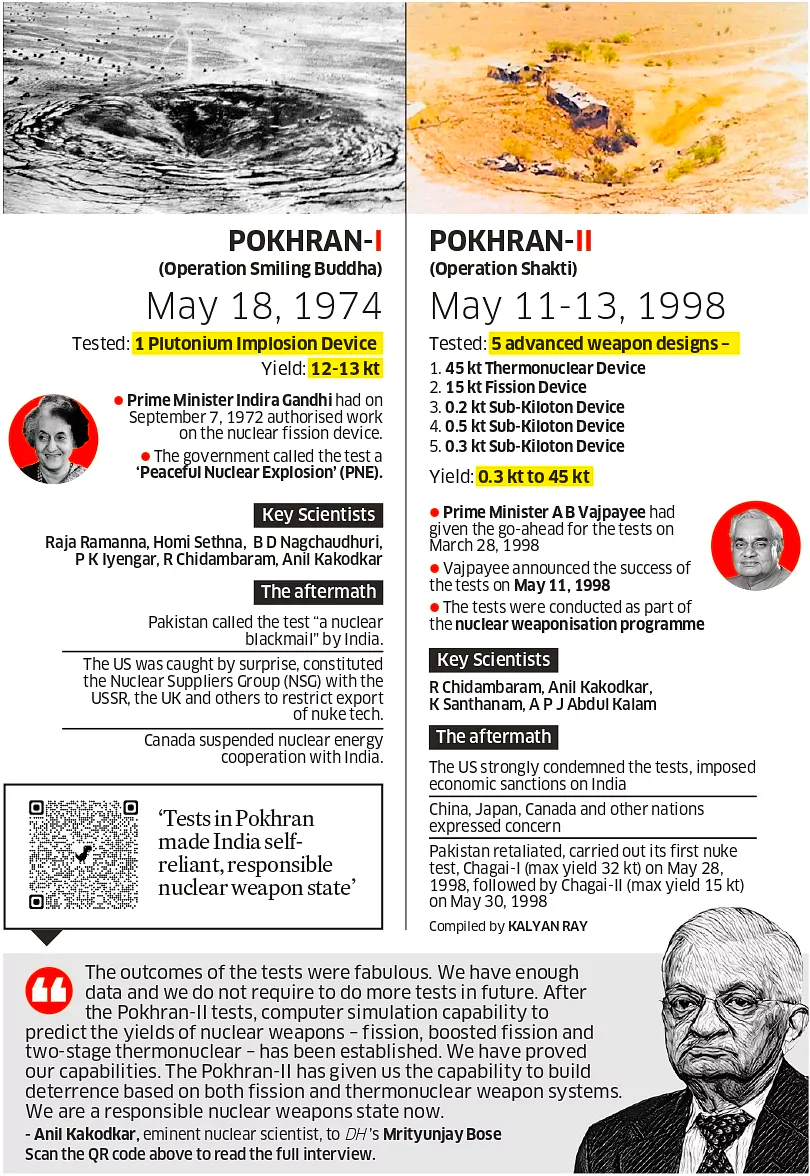Context
Fifty years ago, on May 18, 1974, India conducted its first nuclear tests in Pokhran, Rajasthan, as part of the ‘Smiling Buddha’ operation.

50 Years of Pokhran-I, Background to India Conducting its Nuclear Tests
- Post-World War II Era: Following the end of World War II in 1945, new global alliances and alignments emerged amidst the Cold War between the US and USSR.
- Nuclear Nonproliferation Treaty (NPT): To maintain a kind of minimal peace, the NPT was signed in 1968.
- It defined nuclear-weapon states parties as those that manufactured and exploded a nuclear weapon or other nuclear explosive devices before January 1, 1967, effectively meaning the P-5 countries (the United States, the United Kingdom, France, China and Russia).
- India’s Discontent: India objected to this treaty on the grounds that it was discriminatory to countries except the P-5.
 Domestic Developments: Indian scientists Homi J Bhabha and Vikram Sarabhai had laid the groundwork earlier for nuclear energy to be tested in India.
Domestic Developments: Indian scientists Homi J Bhabha and Vikram Sarabhai had laid the groundwork earlier for nuclear energy to be tested in India. -
- In 1954, the Department of Atomic Energy (DAE) was founded, with Bhabha as director.
Enroll now for UPSC Online Course
About Pokhran-I
- Support by Political Leadership: On September 7, 1972, Indira Gandhi authorized the Bhabha Atomic Research Center (BARC) to develop and prepare a nuclear device for testing.
Why in Pokhran?
- To maintain the secrecy of the test, the Pokhran is a remote location in the Thar Desert of Rajasthan’s Jaisalmer district.
- The test was conducted during the month of May when the wind in the region created serious sandstorms.
- The sandstorms obstruct a clear view to American spy satellites.
- Also, the infrared sensors do not pick up such activity due to the temperature that increases over 50 degrees during the daytime.
|
- Maintenance of Secrecy: With the treaties that the P-5 had in place, India decided to conduct the nuclear test at Pokhran in 1974 without any prior information being released to the world.
- Location & Codename: Pokhran, an army test range located in the desert of western Rajasthan, was chosen and its code name “Operation Smiling Buddha” came from the test’s date being on the same day as Buddha Jayanti, the birth date of Gautam Buddha.
- The Ministry of External affairs designated it as Pokhran -1.
- A nuclear device was detonated, with a yield of 12-13 kiloton of TNT, on May 18, 1974.
- India became the sixth country in the World to conduct a successful Nuclear Test.
Reactions after Conduction of the Test
- International Criticism: Almost all countries have condemned India’s nuclear test.
- Canada imposed heavy sanctions. Even in 1978, the US signed the Nuclear Non-Proliferation Act, following which the US ceased exporting nuclear assistance to India.
- Establishment of the Nuclear Suppliers Group (NSG): NSG was formed in response to this nuclear test.
- The US pushed for setting up a club of nuclear equipment and fissile material suppliers.
- Its purpose is to control exports of nuclear-related materials and machinery.
- Diplomatic Efforts: India has projected itself as a “responsible” owner of these weapons, allowing acceptance among countries and into groups like the NSG.
- India has been trying, since 2008, to join the NSG. Many countries that initially opposed its entry, like Australia, have changed stance; Mexico and Switzerland are the latest to voice support. India faces the only resistance from China.
- Strategic Shift: India asserted itself as a nuclear-capable nation, paving the way for future developments like Pokhran-II in 1998.
- In 1998, under the leadership of Prime Minister Atal Bihari Vajpayee, India conducted a series of nuclear tests in Pokhran once again, code-named Operation Shakti.
Enroll now for UPSC Online Classes
![]() 18 May 2024
18 May 2024

 Domestic Developments: Indian scientists Homi J Bhabha and Vikram Sarabhai had laid the groundwork earlier for nuclear energy to be tested in India.
Domestic Developments: Indian scientists Homi J Bhabha and Vikram Sarabhai had laid the groundwork earlier for nuclear energy to be tested in India. 